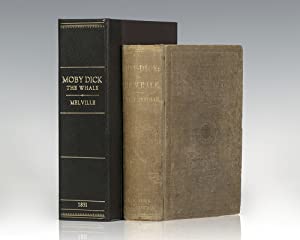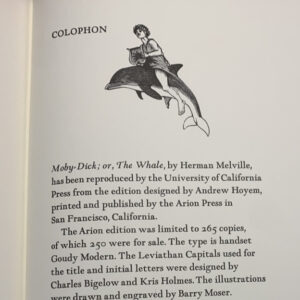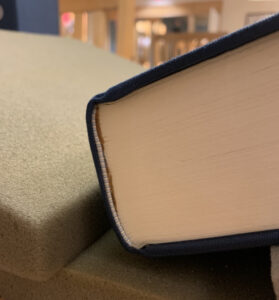Moby Dick; or, the Whale, was adroitly handcrafted and produced by the Arion Press in 1979. This sensation of a book has a storied creation that reinvigorates the importance of the seemingly lost art of bookmaking in modern society. This book is unique because it was created by the last functional letterpress publisher in the country; its existence proves that the attention paid to the smallest details from a customized font to a hand-sewn headband has a substantial impact on how the work is perceived and valued.

First edition of Moby Dick, published by Harper & Brothers, New York, 1851
The author of this classic adventure novel has become a household name, meaning Herman Melville’s life and turbulent career has been meticulously cataloged by scholars and historians. Although his book is widely regarded as a masterwork of literature, Moby Dick was largely overlooked and even criticized during his lifetime (“How Melville’s Moby-Dick went from flop to literary masterpiece”, www.historyhit.com). While Melville was alive, he sold a mere 3,000 copies of the book in the U.K. and America combined (www.historyhit.com). In fact, during Melville’s career his book Typee experienced more praise and popularity due to its easy thrill factor and comparative lightheartedness. His stories are recognized as dramatized accounts of his life and experiences with whaling (“Herman Melville – the years of acclaim”, www.britannica.com). Starkly contrasting this past unpopularity, Moby Dick has become a cultural staple, in turn making the original edition and the modern Arion press edition valuable artifacts. The book’s success is marked by the hefty price tags — the first edition is on the market for $65,000, while the Arion press version is also valued in the thousands (“Moby Dick by Melville, First Edition”, www.abebooks.com). Overall, Moby Dick is considered a classic today due to its shameless critique of 19th century conventions and its philosophical nature.
Moby Dick was brought to life by a modern-day printing press (also functioning as a publisher) that values awe-inspiring quality and a level of precision that is unmatched in any mass-produced book. The Arion Press, founded in 1974, is a San-Francisco based company that specializes in limited edition handmade works. Each book they produce is the product of a laborious process that begins with the careful planning and design and ends with the execution of the handcrafted binding. Today, Arion Press is regarded for its magnificent accomplishments with works such as Frankenstein, Sense & Sensibility, Don Quixote, Paradise Lost, and several more pieces of esteemed literature. Overall, Moby Dick was the sixth chronological production from this company out of nearly 125 books (“Catalogue”, www.arionpress.com). Printing the colossal Moby Dick was an ambitious goal to pursue, especially considering that the dense text was entirely handset.
Despite the printing industry being threatened by the modernization of the reading process, Arion Press defies these social obstacles by using the artful craft of bookmaking to pay homage to classic works of literature. The major names associated with this work can be found in the colophon — Andrew Hoyem, Charles Bigelow, Kris Holmes, and Barry Moser. Hoyem is the founder and most prominent force in the company. He was closely involved in the executive decisions for design and course of action for the book, and oversaw the mechanical tasks regarding the production of the text (“About Arion Press”, www.arionpress.com). Moreover, the team of Bigelow and Holmes toiled over the design of the custom-made Leviathan typeface, attempting to bring the significance of the writing into a visual composition. For the bulk of the text, Bigelow and Holmes used the Goudy modern font, a variation of the Goudy open with the letters filled in (“Goudy Modern in use”, www.fontsinuse.com). Moreover, Barry Moser was commissioned to complete 100 wood-engraved illustrations for the book, and he was challenged by restrictions to not portray pivotal action scenes or major characters (“A Note on the California Edition”). Notably, the book is a clear distinction from identically mass-produced works, in which excellence is sacrificed for a lower price.
most prominent force in the company. He was closely involved in the executive decisions for design and course of action for the book, and oversaw the mechanical tasks regarding the production of the text (“About Arion Press”, www.arionpress.com). Moreover, the team of Bigelow and Holmes toiled over the design of the custom-made Leviathan typeface, attempting to bring the significance of the writing into a visual composition. For the bulk of the text, Bigelow and Holmes used the Goudy modern font, a variation of the Goudy open with the letters filled in (“Goudy Modern in use”, www.fontsinuse.com). Moreover, Barry Moser was commissioned to complete 100 wood-engraved illustrations for the book, and he was challenged by restrictions to not portray pivotal action scenes or major characters (“A Note on the California Edition”). Notably, the book is a clear distinction from identically mass-produced works, in which excellence is sacrificed for a lower price.
Furthermore, the quality of this copy’s paper is unmatched by the thin and flimsy paper used in mechanically manufactured books. In the front matter of the book, “A Note on the California Edition” describes the paper as being handcrafted with faint whale-shaped watermarks on the corner of select pages; this distinct practice reflects the companies’ continued implementation of old-fashioned machinery. Furthermore, the models of 19th technology are used to create the text printed on the paper. A caster in Arion Press’s type foundry is used to create individual pieces of type that will be used to print the book (“About Arion Press”, www.arionpress.com). Each individual piece of type was meticulously forged then laid out, employing methods and technologies that recreate the feel of valuable books made in earlier centuries. Full-time type casters are of extreme rarity today, yet they hold an essential position in establishing works of art that will be read and appreciated by many in subsequent years. The hand cast type lends character to the book, allowing every aspect of the product to be conscious and deliberate instead of mechanically reproduced without any thought. This handset and handmade ty

pe is not reproducible. Although it may be imitated, the Arion edition possesses qualities of type and execution that are exclusively theirs.
The exquisite quality of the book is carried into the process of binding, where an individual punches holes in the printed sections ofthe book before it is sewn. This job could very efficiently be done with a machine to several books in rapid succession, yet the use of a physical person reinforces the importance of the careful handcrafted nature of the book (“About Arion Press”, www.arionpress.com). The book was bound in-house, hand sewn with extreme care. In the final step of the process, the cover is glued to the book and the finished product is put on sale.
Arion Press’s Moby Dick was presented to the public in the original Arion Edition, and later, the California Deluxe Edition. To the untrained eye, not much seems to be different between the two editions. However, the most jarring change is the material of the cover. The original book exhibits a blue Moroccan goatskin cover, whereas the California Deluxe displays a buckram cloth in the same oceanic blue. Furthermore, the newer edition was not printed from the handset type. Instead, the pages are high quality photographic replications of the originals. Ultimately, the changes demonstrate a shift creating a work that can be appreciated by the public, bringing the price down from $1,000 (a value that has appreciated since the initial sale) to significantly less (Davis, Moby Dick; published by University of California Press & Arion Press).
Overall, the book was successful in its mission of providing a work of art that reconciles the past of bookmaking and the modern desire for high quality books. It was magnificent learning about the process of making this book because I was able to fully grasp how a great variety of people contributed to the creation of this work of art. The font used for this paper, Goudy type, is loosely based on the tasteful and elegant font used for the Arion Press’s interpretation of Melville’s famous work. With this edition of the book, several elements combine to generate a physical object deserving of the title ‘perfection’.
Works Cited
“About Arion Press.” Arion Press, https://www.arionpress.com/arion-about.
“Catalogue.” Arion Press, The Arion Press, https://www.arionpress.com/arion-catalogue.
Davis, J. “Moby Dick; Published by University of California Press & Arion Press.” The Whole Book Experience, 14 Sept. 2014, https://www.thewholebookexperience.com/2014/09/13 /moby-dick-published-by-university-of-california-press-arion-press/.
“Goudy Modern in Use.” Fonts in Use, https://fontsinuse.com/typefaces/47/ goudy-modern.
History Hit, 3 Aug. 2022, https://www.historyhit.com/culture/american- publication-moby-dick/. “Moby Dick; or, the Whale.” AbeBooks, Harper & Brothers, New York, https://www.abebooks.com/servlet/SearchResultsan=Melville&bi=0&bx=off&ds=30&fe=on&pics=on&recentlyadded=all&sortby=1&t n=Moby%2BDick&x=48&y=18&yrh=1851&yrl=1851.
Irvine, Amy. “How Melville’s Moby-Dick Went from Flop to Literary Masterpiece.”
“Melville, Herman (1819–91),” The Oxford Companion to Ships and the Sea, edited by I. C. B Dear, and Peter Kemp, Oxford University Press, Inc., 2nd edition, 2016. Credo Reference, https://dickinson.idm.oclc.org/login?url=https://search.credoreference.com/content/entry/oupavue/melville_herman_1819_91/0?institutionId=2613. Accessed 13 Apr. 2023.
“The Years of Acclaim of Herman Melville.” Encyclopædia Britannica, Encyclopædia Britannica, Inc., https://www.britannica.com/biography/Herman-Melville/The-years-of-acclaim.
Nice work, Mary!